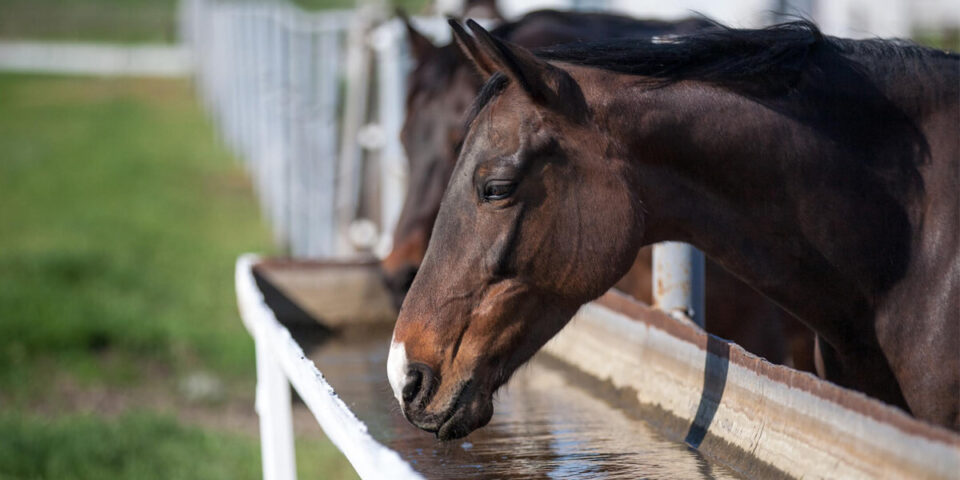
It’s easy to spend a fortune on the next fancy feed, supplement or gadget. Sure, there are plenty of worthwhile products that may very likely improve health and reverse illness, but none of them truly matter without meeting these five foundational principles. These are true for all horses, regardless of age, breed, condition, or purpose. Even seasonal or regional variations do not alter these.
Here is what every horse needs. Period.
Water – the most important nutrient
It must be plentiful, clean, and of the right temperature to encourage horses to drink. A horse at maintenance, living in a temperate climate will require a minimum of ½ to 1 gallon per hundred pounds of body weight. For the 1100 lb (500 kg) horse, that equates to 5.5 to 11 gallons (21 to 42 liters) per day. However, his demand for water will increase with activity and warmer temperatures. Here are some factors to consider:
- Water must be freshened daily. Dead insects, bird droppings and excessive pond scum can poison your horse. Using smaller water troughs can make cleaning easier.
- Never add salt or electrolytes to your horse’s only water supply. Plain water must always be available.
- Pasture is high in moisture, typically containing 60 to 80 percent water, whereas most hays have only 7 to 10% moisture.
- High protein diets increase water requirements since protein can have a diuretic effect.
- During cold weather, horses drink less, especially if the water is ice cold. This potentially leads to dehydration – the main cause of colic in the winter. Heating water between 45 and 60 degrees F (7 to 15 degrees C) will promote more water consumption. Be sure the heater has no exposed wires that could electrify the water source.
- If you rely on creeks or ponds, the water must be moving and deep enough to not freeze.
- Snow consumption will not meet your horse’s water requirement. One gallon of average snow contains only 10 ounces of water. Also, eating snow will force your horse to burn precious calories needed to keep his body temperature steady.
Salt is required daily, regardless of the season
In cold seasons, salt helps promote that all-important water consumption. In warm seasons, supplemented salt replaces what is lost from perspiration. A full-sized horse requires at least one ounce (two level tablespoons or 30 ml) of salt each day for maintenance — this much provides 12 grams of sodium. Heat, humidity, and exercise increase the horse’s need. There are several ways to accomplish this:
- Granulated salt can be offered free-choice. Check your source for prussic acid, an anti-caking agent. This contains cyanide and should be avoided.
- Mined sea salt offers many minute quantities of trace minerals that are typically not available in the average diet.
- A salt rock should be available should your horse want more. Experiment with different natural types to see what your horse enjoys most. Many horses, however, are not comfortable with constant licking.
- If salt consumption is too low via free-choice feeding, calculate the amount of sodium your horse is getting from any commercial feeds or supplements and add salt accordingly. (For palatability, limit the amount to no more than 1 tablespoon per meal.)
- Do not offer electrolyte supplements instead of plain salt. Electrolytes are meant to replace perspiration losses and fed in addition to salt. Never add electrolytes to your horses only water supply.
- Watch the iodine content in mineralized salt preparations. Too much iodine, and not enough selenium, can damage the thyroid gland. Iodine and selenium intakes need to be similar.
Forage is the foundation of the diet – it must flow through the digestive tract 24/7
Horses are grazing animals and are designed to consume forage virtually all day and night, only taking a few minutes here and there to rest; this also includes ponies, minis, donkeys, and mules. There are many reasons why your horse must always have hay and/or pasture:
- The horse’s stomach produces acid continuously, even when empty. The acid in an empty stomach can lead to the formation of ulcers anywhere along the gastrointestinal tract.
- The cecum, where fiber is fermented, has its entrance and exit at the top; therefore, it must be full in order to evacuate digested forage. If not, substances sink to the bottom, potentially leading to impactions and sand colic.
- The digestive tract consists of muscles which are “exercised” by the steady flow of forage. “Flabby” muscles can twist or intussuscept (telescope)—increasing the risk of colic.
- An empty stomach causes incredible stress, creating a hormonal response that raises insulin, an inflammatory hormone that can potentiate laminitis. Elevated insulin also tells the body to store fat.
- Stress from forage restriction can lead to obesity, a damaged metabolic rate, laminitis relapses, and inflammation of the hypothalamic region of the brain, accelerating the development of leptin resistance and even Cushing’s disease.
- Elevated stress also impacts immune function, making your horse more susceptible to infections and allergies, as well as negative reactions to vaccinations.
Don’t let anyone scare you into thinking that feeding hay free-choice will damage your horse. Please read “Equine Digestion – It’s Decidedly Different” to empower you with the knowledge needed to help your horses. Hay testing and commercially available “slow feeders” are worthwhile for many horses.
Replace what hay is missing
Many horses rely entirely on hay for their forage needs. Is hay nutritious? Not very. Hay is dead grass; it no longer contains many of the vitamins, omega 3s and omega 6s it once had as living pasture. It does, however, contain protein, carbohydrates, and minerals, and is a significant source of energy. Consider the following to fill in the nutritional gaps:
- Add a comprehensive vitamin/mineral supplement that offers what hay is missing — beta carotene (or vitamin A), vitamin D, and vitamin E.
- Vitamin C is lost in hay; however, young horses’ bodies produce adequate amounts. As horses age, the liver can become less efficient at synthesizing this vitamin.
- Add a variety of protein sources by feeding several types of forages. When only one type of hay is fed, the protein quality of the diet is poor and can prevent your horse from replacing and repairing tissues throughout the body.
- Sunlight exposure is needed for vitamin D production. The precursor to vitamin D is naturally found in grass, but diminishes the longer hay is stored.
- Simulate the fatty acid content of grasses by providing a feed source that has more omega 3s than omega 6s. Chia seeds or ground flaxseeds are good choices.
Movement, companionship and shelter are vital necessities
Horses need to move and have the protection of a buddy. Standing in a small area for hours on end (even if part of it is outdoors) takes its toll on your horse’s mental and physical health. So does being isolated from buddies. The stress can be so great that it dramatically diminishes your horse’s quality and length of life by compromising his immune system and hormonal responses. We see the effect in a vast variety of health issues:
- Obesity, insulin resistance, loss of muscle mass, and sluggish metabolic rate
- Porous bones and potential fractures
- Inadequate blood circulation, reducing the flow of nutrients and oxygen to the feet, joints, tendons/ligaments, and hair follicles
- Potential for digestive disorders including colic, ulcers, and diarrhea
- Compensatory behavior, including weaving, stall-walking, pawing, wall-kicking, chewing, head-bobbing, self-biting, and even cribbing
- Slowed cartilage and joint development in growing horses
- Accelerated aging, increasing susceptibility to infections, insect-borne diseases, and allergic responses
- Increased oxidative stress, promoting degenerative diseases such as arthritis and equine Cushing’s disease at a younger age
Horses also need shelter from harsh weather. This can best be accomplished by offering your horse the option to make choices. Barn stalls that can be entered and left at will through open gates allow your horse to decide what is most comfortable.
Bottom line
Horses are individuals and may need additional nutrients and care, but covering the basics of water, salt, forage, necessary supplementation, movement, stress reduction, and shelter will optimize your horse’s foundation for a lifetime of vibrant health.
By Juliet M. Getty, Ph.D. For more information



